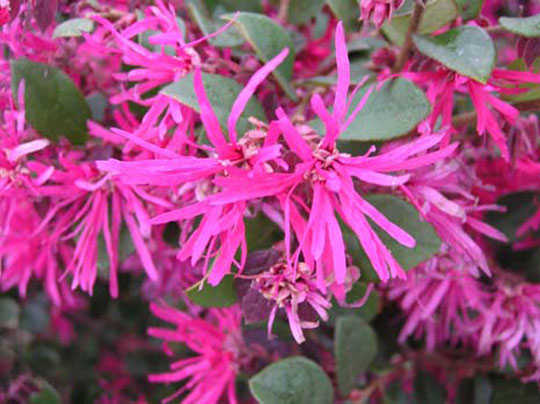Looking To Landscape? Try Chinese Purple Leaves And Pink Flowers
April 10, 2010
Loropetalum, a native of Japan and Southeastern Asia, was introduced to the United States about 1880. However, it wasn’t until the introduction of the purple-leaved and pink flowering forms around 1990 that this plant began to find its way into the landscape. Based on its usage, it appears to be among the most popular broadleaf evergreens in southern landscapes. Both the botanical name, Loropetalum chinense, and the common name, ‘Chinese Fringe Flower’, refers to the shrub’s unique strap-like flowers. The shrub displays clusters of white or pink flowers with narrow petals that dangle like fringe. Although spring is the main flowering time, the shrub will flower off and on throughout the summer and into the fall.
Loropetalum (lor-o-peta-lum) has evergreen foliage with the color varying depending upon the variety. Loropetalum varieties in the market place today are very similar, and yet, there are distinct differences. There are unique shades of flower color, ranging from fuchsia-pink to pink, or white with pink. Some have consistently reddish-purple leaves and others are green to purple depending on environmental conditions and time of year. All have a rapid rate of growth.
Its growing habit is loose and open and makes a great foundation plant, under-planting, screen or hedge. It can also be used in containers, or as a subject for espalier or bonsai.
At first, the young plants look small and delicate. But they grow fast, reaching 8 to 12 feet tall and nearly as wide. So space new plants appropriately.
 Loropetalum grows well in moist but well-drained soil and becomes drought tolerant once established. Color is almost equally good in sun and shade. It prefers slightly acid soil, has few pest or disease problems, and only needs pruning to control size. It benefits from fertilization two to three times a year.
Loropetalum grows well in moist but well-drained soil and becomes drought tolerant once established. Color is almost equally good in sun and shade. It prefers slightly acid soil, has few pest or disease problems, and only needs pruning to control size. It benefits from fertilization two to three times a year.
Loropetalum ‘Ruby’ has long been considered a fairly low maintenance landscape plant with few insect or disease problems. However, in recent years, there have been increasing reports and complaints of unexplained decline, especially in central Florida. The most commonly reported symptoms of decline include new growth that is stunted or deformed, curling of leaves, defoliation, and in extreme cases, plant death. Possible explanations for Loropetalum decline include mites, nutrient deficiency (especially micronutrients), root rot, nematodes and salt toxicity.
The University of Florida currently recommends planting ‘Burgundy’, ‘Plum’, or another cultivar with similar characteristics to ‘Ruby’, since there have been no reports of widespread decline for these cultivars in Florida. The following tips will help you to identify different cultivars.
- Loropetalum ‘Ruby’ is a small (3-5 ft tall), rounded plant with leaves that are more rounded and pink flowers that bloom year round.
- Loropetalum ‘Burgundy’ (also called ‘Sizzling Pink’) will stand more upright than ‘Ruby’ and grows to be 6-10 ft tall. It has elongated, pointed leaves that turn bright red in the fall and flowers that bloom intermittently.
- Loropetalum ‘Plum’ (also known as ‘Hines Purpleleaf’, ‘Plum Delight’ or ‘Pizzazz’) has dark foliage and tends to have smaller, darker flowers. This cultivar will grow to be 6-8 ft tall.
Due to its vigor and adaptability, many new Loropetalums have become available in the past several years. So, it’s important that you research the size of all these selections prior to placing them in your landscape. Be sure to pick a variety that is suited for your planting space.
Comments
9 Responses to “Looking To Landscape? Try Chinese Purple Leaves And Pink Flowers”




well i have that miracle grom handle that you plug into the water hose and it spryas the miracle grow and water. Do you think that would work??
brooke
We had one that we forgot to water to the point that leaves were falling off. But with continued watering, it recovered. We also used a little Miracle Grow.
I just transplanted a bunch of these and they dont look to good. They have only been replanted for about 4 days and i water them everyday until they start growing but they are wilted and look like they are dying. Anyone have any suggestions on keeping them alive or something I could do to give them a boost???
I’ve seen them before at Central Farm Supply and Marvin’s.
THIS IS SUCH NEAT INFORMATION. DOES ANYONE KNOW WHERE WE CAN PURCHASE THESE PLANTS IN THE ATMORE AREA?
THANKS WILLIAM!
They will get big if you do not keep trim back. Easy to trim because the linbs are not that big .
I have tons of these around the yard. They can get very big if you do not keep them trimmed. I live in North Alabama now, and mine blooms twice a year fully and a few in between. The leaves stay purple year round but towards the end of winter they are very light purple. I love them and they add tons of color. I would encourage anyone down there to add them to your landscape. They add such beauty!
I personally know not to purchase plants not native to our area. Have had some bad experiences.
My favorite Loropetalums in Pensacola are at Cracker Barrel. They have a long sidewalk that has them on both sides. They are beautiful.